Rare PDA Casio Cassiopeia A-11A
I got into my hands for the purely symbolic price of a Casio Cassiopeia A-11A PDA - one of the first Casio handheld computers released in late 1996.
Unfortunately, the baby Cassiopeia pretty much ruined life. Firstly, the previous owner unscrupulously lost the wire to connect this PDA to the computer. And secondly, the Cassiopeia A-11A screen began to live its own life and began to turn off at the most unpredictable moment. And then it completely stopped working, as it should be according to the law of meanness.

This machine is noteworthy - on board as much as 4MB of RAM, a Hitachi SH3 processor with a frequency of 40 MHz, Windows CE 1.0, and all this joy from two finger batteries works.
I felt sorry for the poor thing, and I decided to fix it. The repair process and detailed information about the Cassiopeia A-11A, as always, under the habrakat.
Specifications Casio Cassiopeia A-11A
The device runs on the Microsoft Windows CE 1.0 Handheld PC edition operating system.
Appearance
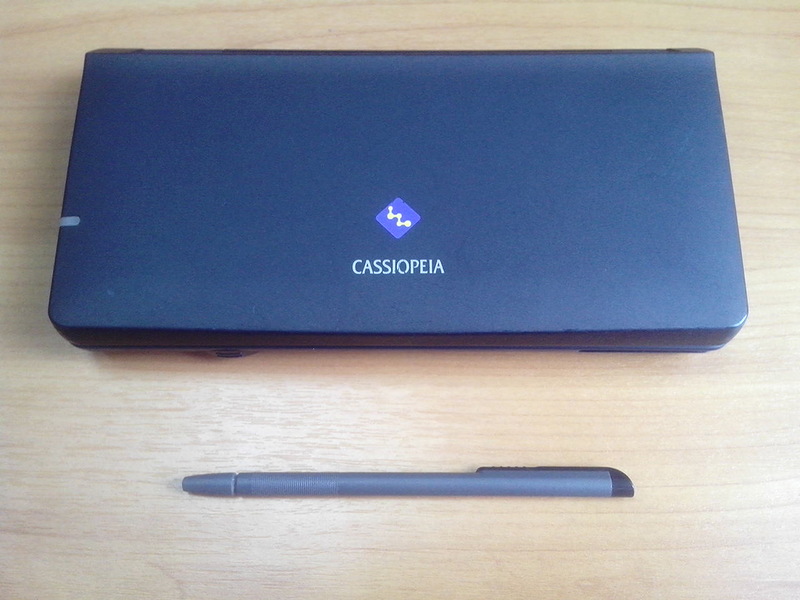
Casio Cassiopeia A-11A is really a very tiny device. The stylus is 11.5 cm long.
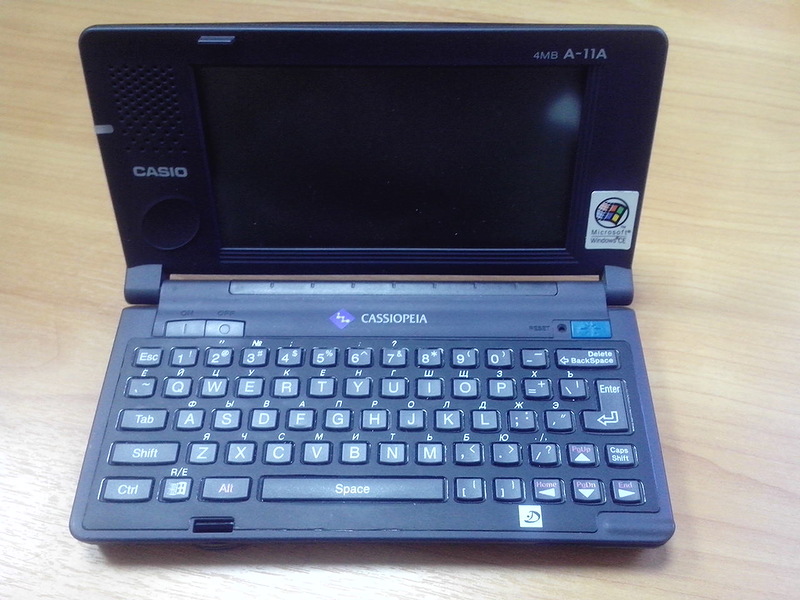
The keyboard of Cassiopeia is Russified. The green key in the upper right corner turns on the backlight.

On the right side is a PCMCIA card slot and a connector for connecting external devices such as a CASIO QV digital camera. The latter is closed with a rubber stopper.

On the left side of the case are: a connector for connecting a data cable, an IR-transceiver window and a contrast adjuster.
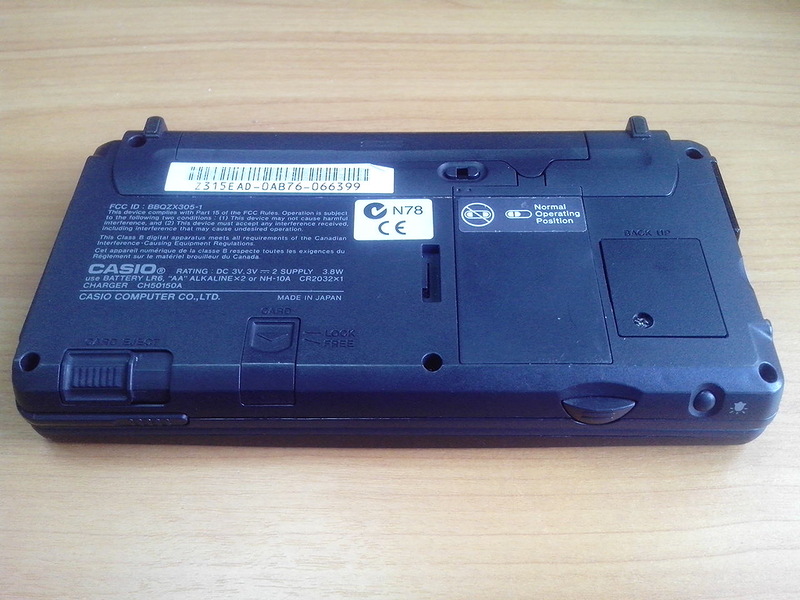
The battery compartment is locked using the slide switch. Its normal position is shown in the picture. The latch and eject button of the PCMCIA card are located in the lower left corner. The stylus retracts into its intended technological hole under the eject button of the PCMCIA card.

The baby Cassiopeia is powered by two finger-type batteries or AA batteries.
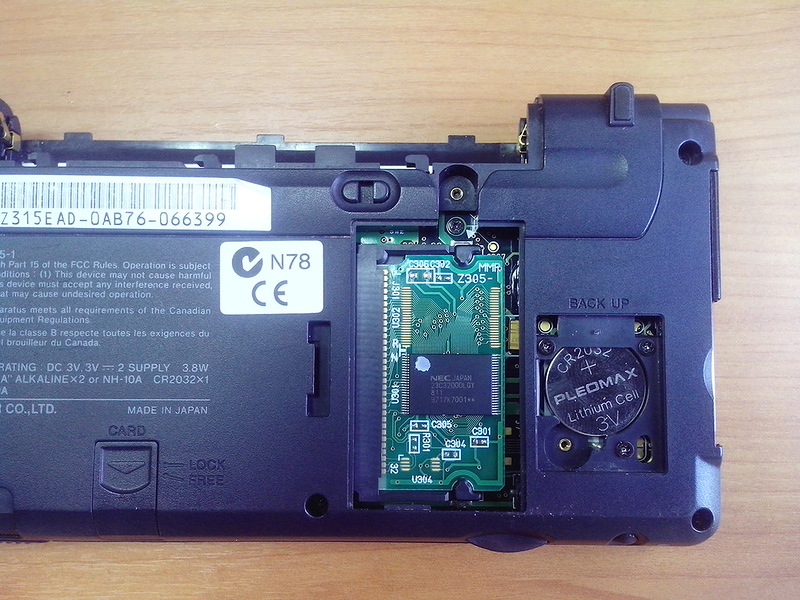
Under the covers tightened by screws, there is a CR2032 battery (it is necessary to save data in case the battery pack is removed) and a ROM card. ROM card (ROM), contains firmware with Microsoft Windows CE 1.0.
Updating the operating system version is possible only by replacing this card with a Windows CE 2.0 upgrade ROM card , which I naturally did not have.
We are repairing Cassiopeia. And, at the same time, taking pictures of the insides
As I said, the malfunction of the Casio Cassiopeia A-11A was a non-working LCD display, and the touchscreen sensor worked fine - the tap on the screen was accompanied by a sound signal.
Naturally, it was first of all necessary to check the integrity of the flexible cable connecting the display to the main board. To do this, I had to completely disassemble the PDA.
First of all, remove the bottom of the Casio Cassiopeia A-11A.

A fairly large part of the space on the main board is occupied by the PCMCIA connector and a slot for connecting a ROM card.
We unscrew all the screws that secure the main board to the case, and carefully lift it from the side opposite the battery compartment. We take out the plastic switch and the latch of the PCMCIA slot. We try not to lose them or crush them.
Carefully open the screwdriver on the latches of the connectors into which the keyboard and display cables are inserted. We pry the battery compartment contacts with a screwdriver (there are four of them, but only the top two are used) and remove them from the seats.
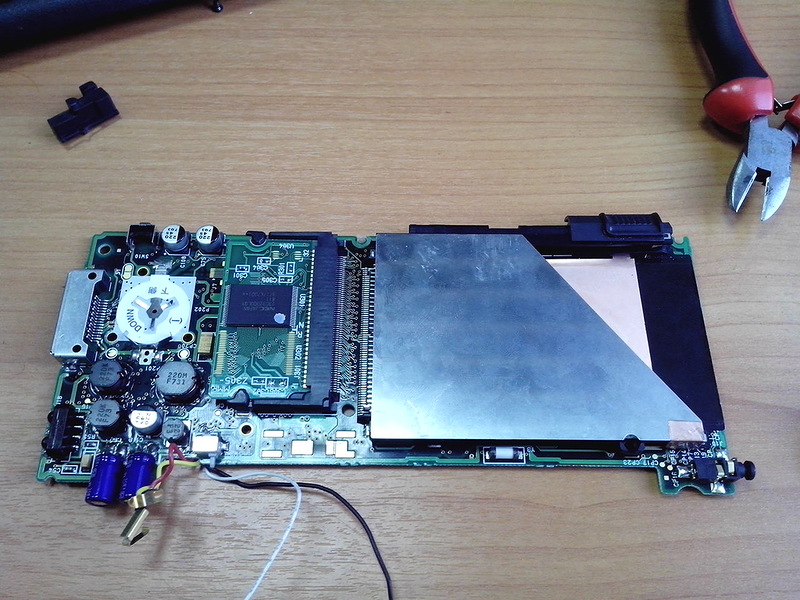
Now the main board can be removed. In the upper left corner is a plastic switch. Do not lose it.
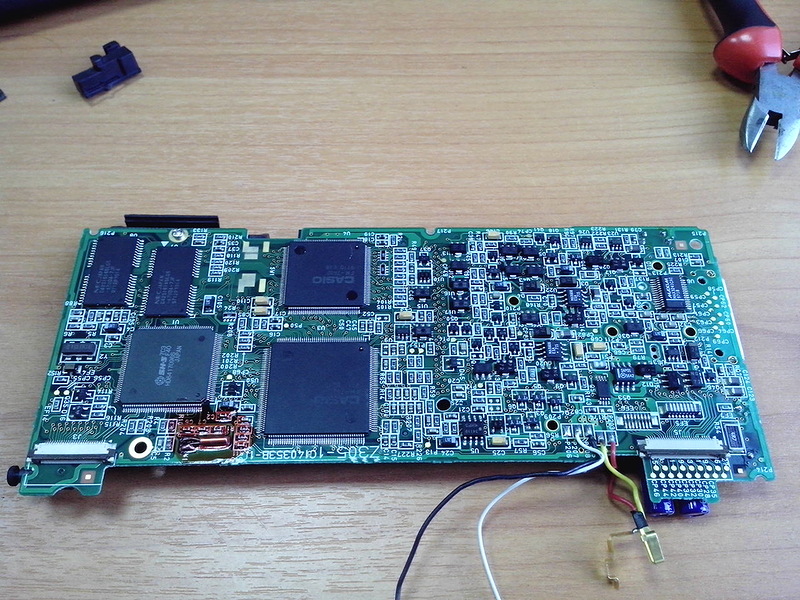
Most of the components, including the processor, are located on the back of the main board.
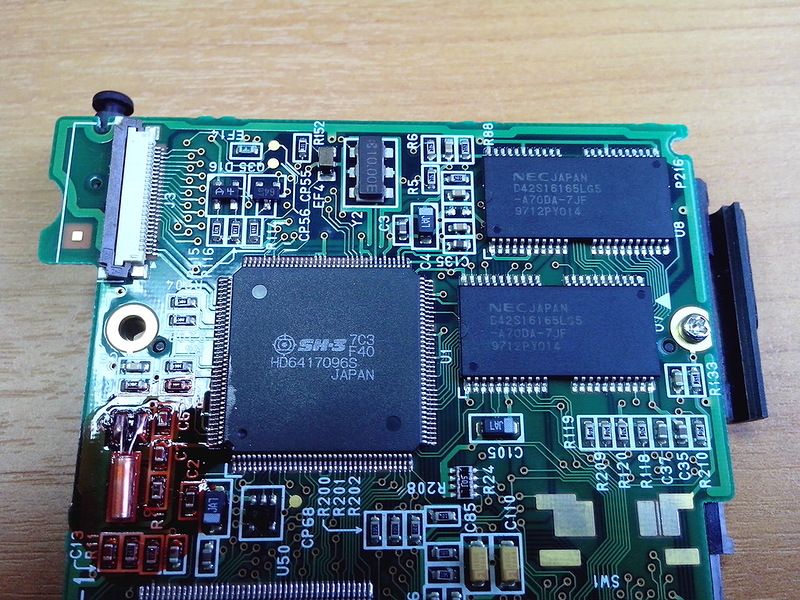
In the upper right corner are two NEC D42S16165LG5 RAM chips with a capacity of 2 MB each.
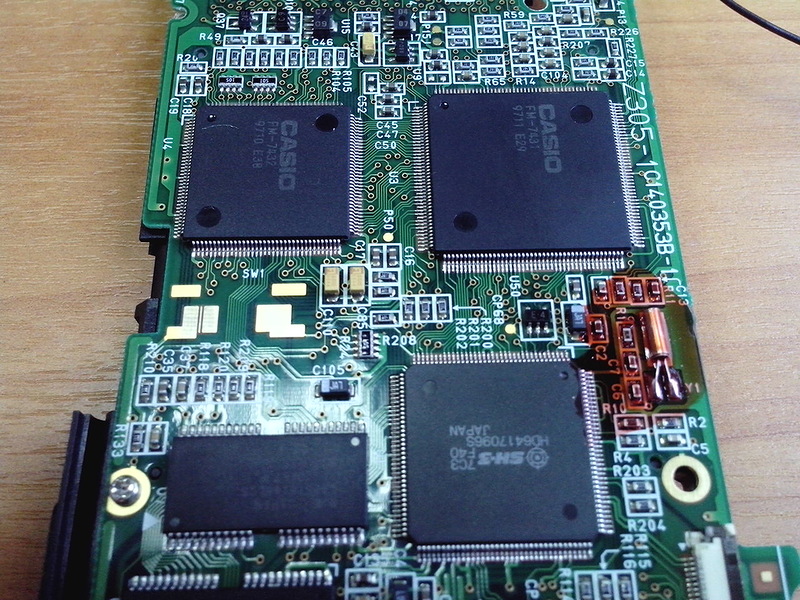
Almost in the center of the main board there are two proprietary chips CASIO FM-7431 and FM-7432. Datashit could not be found on them.
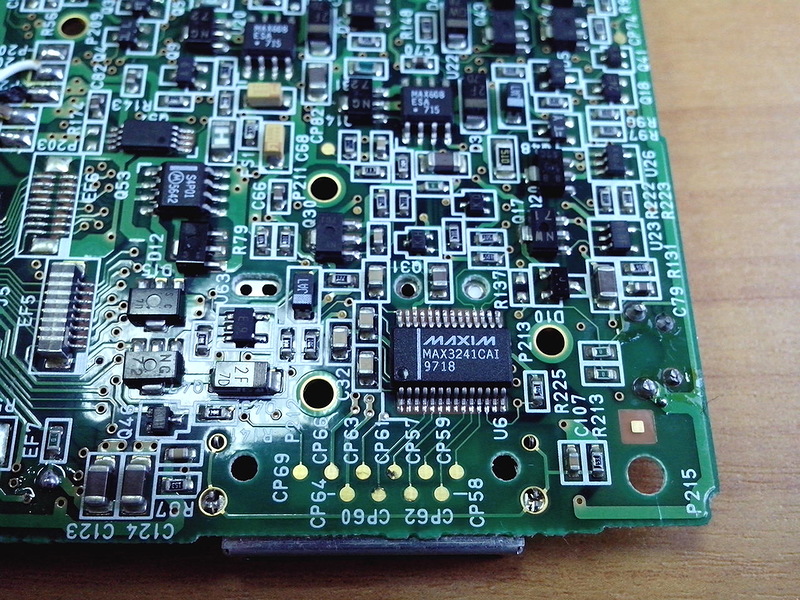
The RS-232 communication interface is based on the MAX3241CAI chip.
We carefully examine the main board for the presence of conspicuous defects. No such found. We clean the connectors for connecting the cables with a brush.
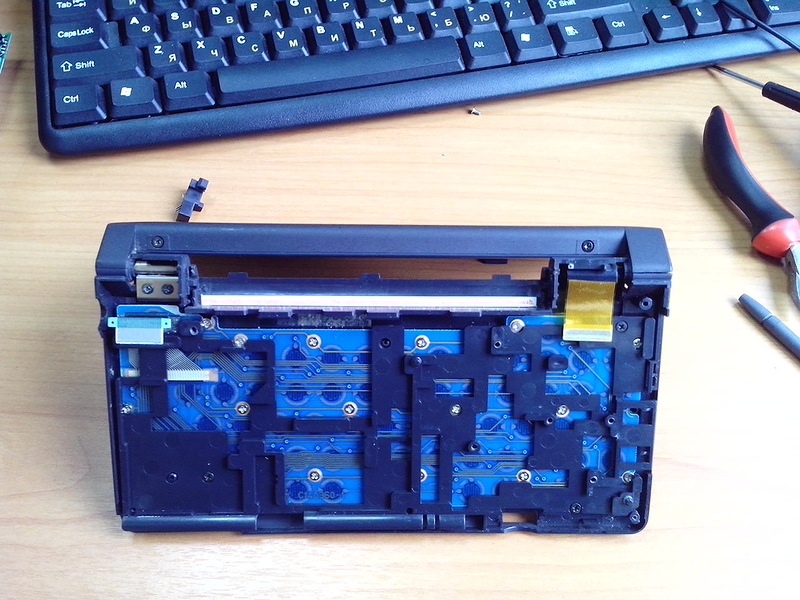
We are armed with alcohol and an eraser, wipe the contacts of the keyboard and display loops.
Now you can try to assemble the Casio Cassiopeia A-11A and test it for performance. And you can not collect, since these manipulations to restore the display did not help.
Well, let's continue to mock the half-corpse. The main task is to remove and ring the display cable.
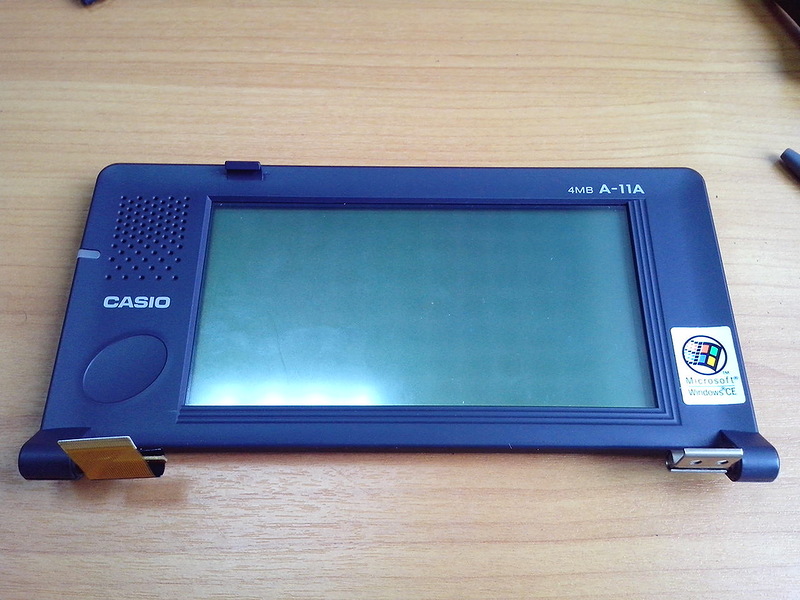
Gently unscrew the screws that secure the display loop and remove it.
We unscrew the two screws connecting the halves of the display case and carefully open it, being careful not to damage the plastic latches.


We release the display board from the screws securing it, and remove it from the case.
The cable connecting the display board to the main board is located just opposite the speaker. We open the latch of the connector and try to pull out the cable, but it wasn’t there! The cable is glued to the printed circuit board, which is not logical, but quite possible.
A little effort and dexterity, and the train is finally freed from glue ties.
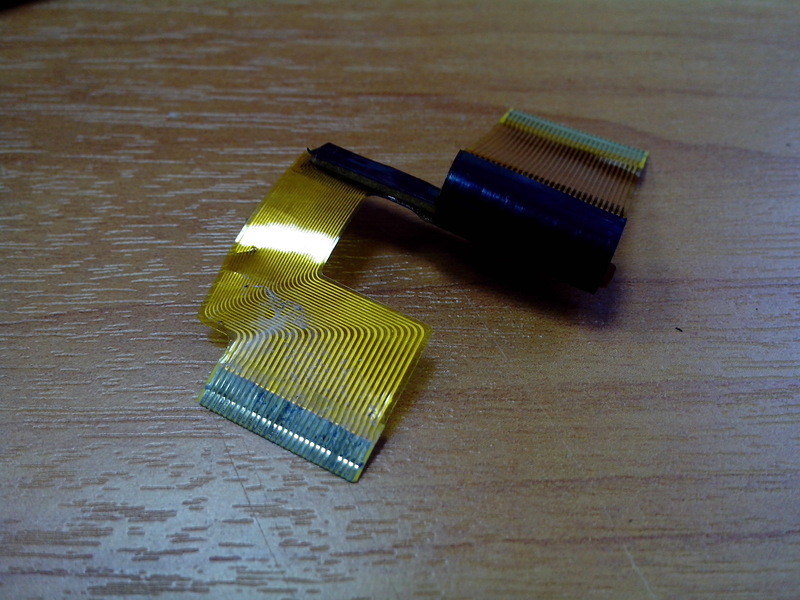
It immediately becomes clear why the display did not want to work. You just look at the state of contacts - you definitely can’t do without alcohol here.
We take an eraser and get rid of the dirt in the spaces between the contact pads, clean the contacts to a shine. Also, a dent was found on the loop (as if it had been pressed with a screwdriver), but thank God it did not affect the integrity of the internal conductors.
Now you can collect the PDA. Repair is over.
First start-up
After assembling Cassiopeia, it is necessary to make sure that there are no extra parts left. For example, I forgot to put the slide switch in place, which commutes the power circuit when the battery pack is inserted and serves as a kind of latch that locks the battery pack in working position.
Turn on the PDA Cassiopeia A-11A.

After the initial configuration of all the parameters, we will find the familiar “Windows” interface.

Have you noticed that the operating system interface, as well as the keyboard layout, unfortunately, is in English? Despite the fact that the qwerty-keyboard of this device is Russified, support for the Russian language in applications must be installed separately, for example, using RusCE / LE .
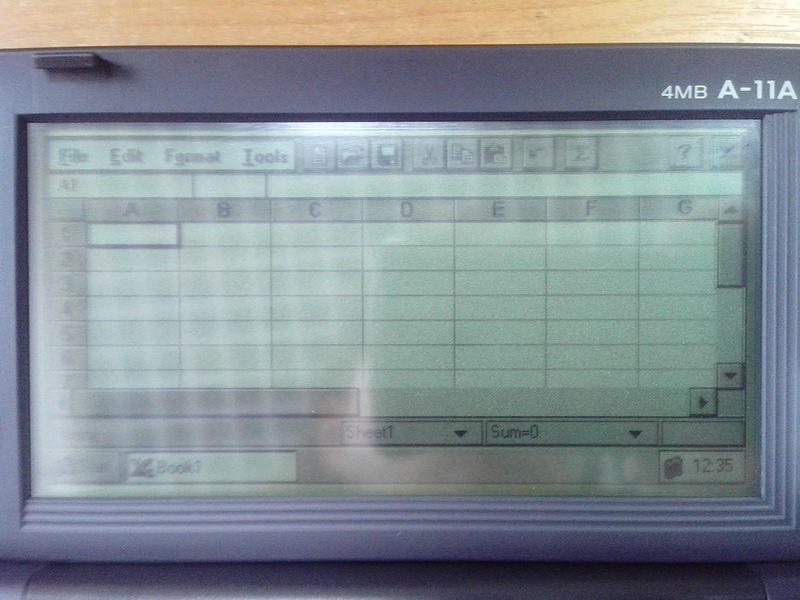
As you can see, office programs Microsoft Word and Excel are already preinstalled on the PDA.
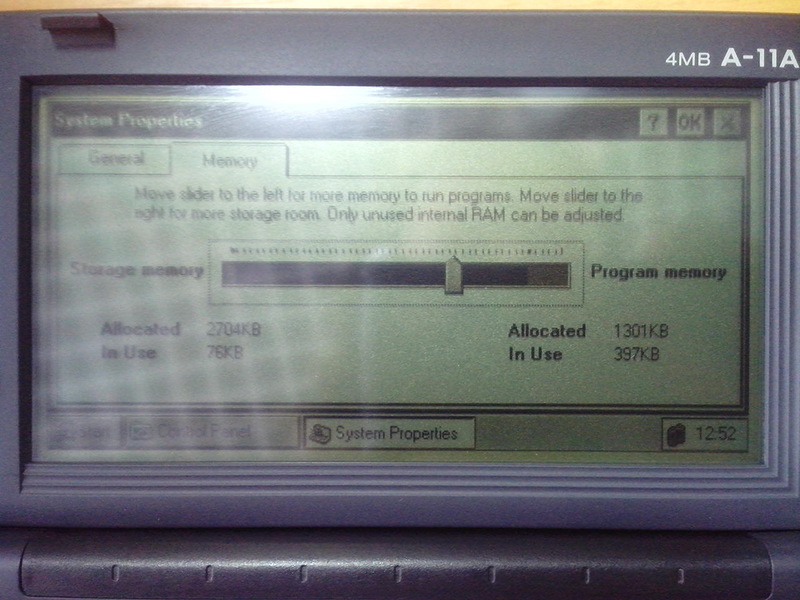
The size of RAM allocated for programs and data can be changed in the control panel.
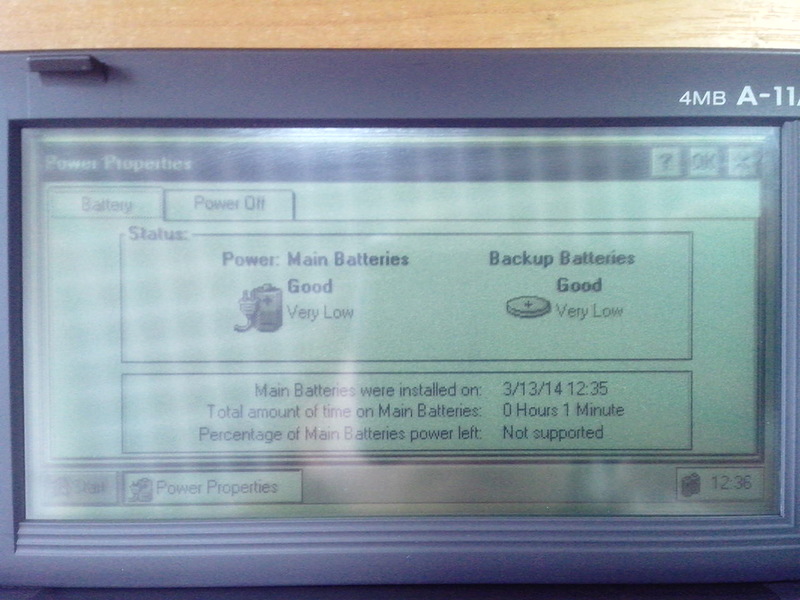
It should be noted that all data is stored in the device’s RAM and disappears if the battery pack and the CR2032 disk element are removed at the same time.
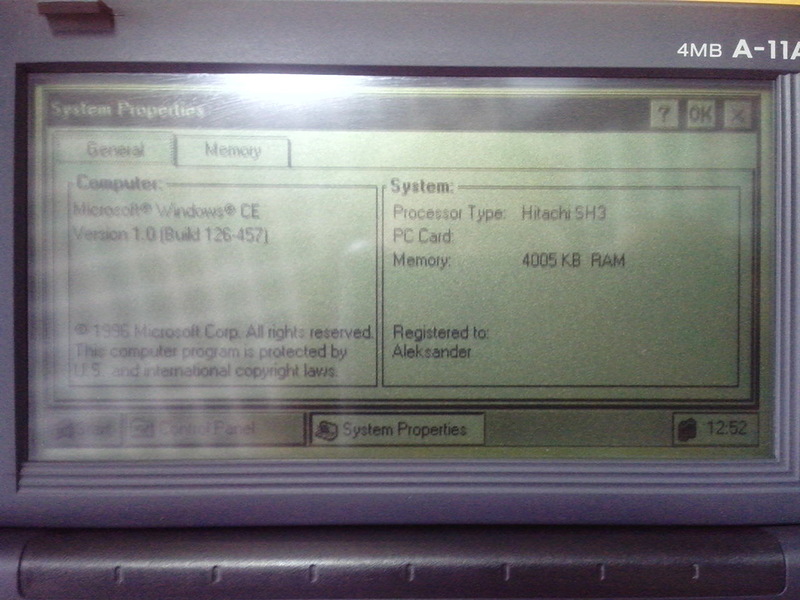
Since the Cassiopeia A-11A has a PCMCIA expansion slot, you could try connecting a CompactFlash flash card to the PDA using the appropriate adapter, but I didn’t have either the adapter or the memory card for a small amount (and I doubt very much that Cassiopeia will be able to digest modern CFs larger than 1GB), so this experiment has been postponed until better times.
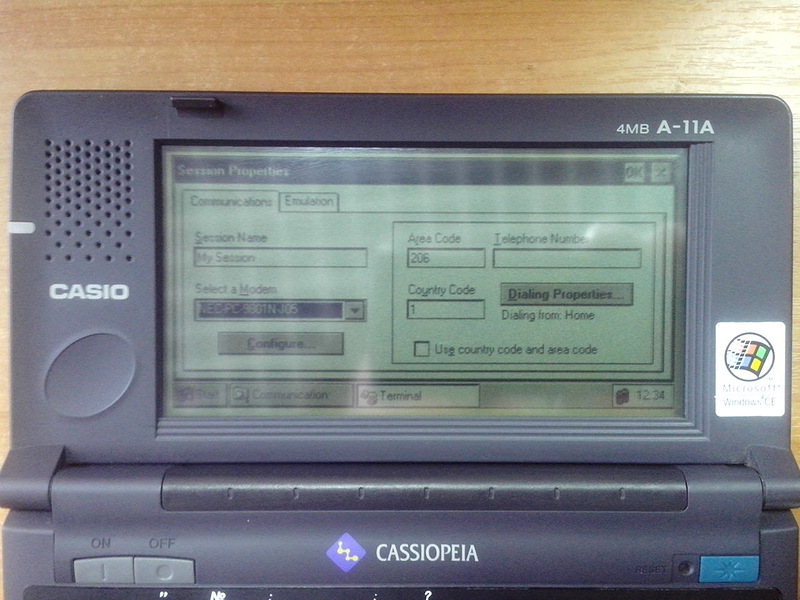
However, you can try connecting some PCMCIA card to the Cassiopeia A-11A, for example, the NEC PC 9801N-J05 modem that was lying around in my hands.
As you can see, it is successfully detected by the system, and with it you can try to connect to the Internet via dial-up. Unfortunately, the Cassiopeia A-11A does not have a pre-installed web browser, and there is no ftp client either, so nothing can be downloaded to the PDA via a network connection.
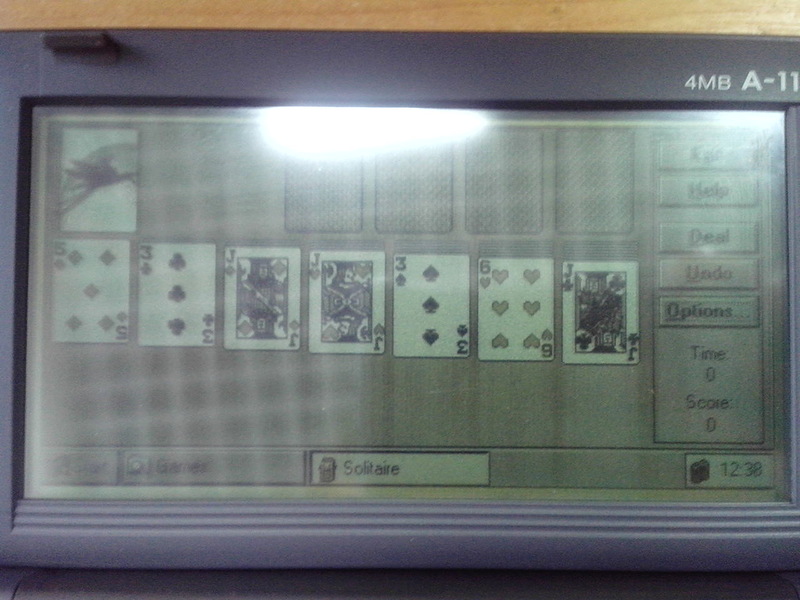
By tradition, I would like to launch some kind of toy on the Cassiopeia A-11A (except for the built-in solitaire, of course), but alas, and without complete wires for connecting the PDA to a personal computer, I don’t have the opportunity to even install the Windows CE interface crack.
The observant reader will say: “Comrade, why do you need a wire? Cassiopeia has an IRDA, throw files with it. ” I hasten to upset you, the infrared port on my Cassiopeia, as it turned out later, does not work. An attempt to transfer or receive a file ends in nothing.
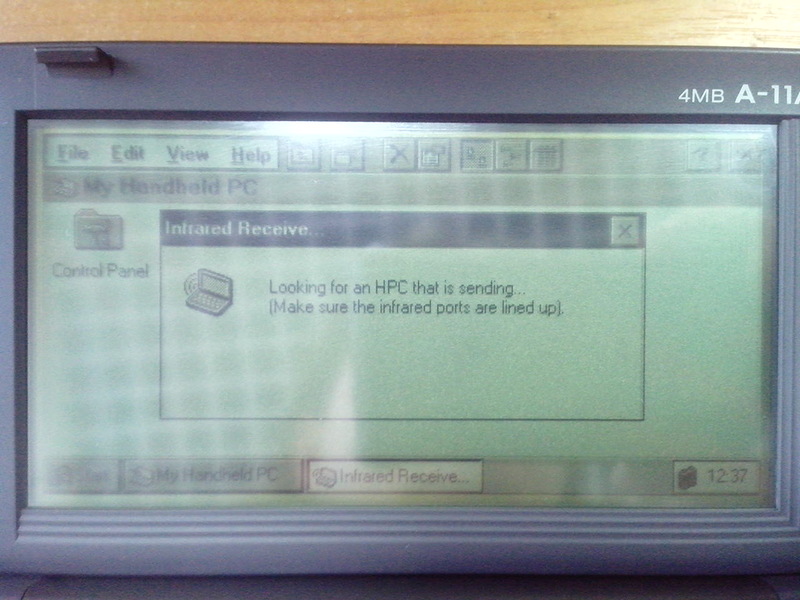
You can look at such a window for a long time, without waiting for the result.
For the purity of the experiment, I tried to pair the Cassiopeia A-11A with several devices: a Fujitsu Siemens Pocket LOOX 410 PDA , a Toshiba Satellite Pro 430CDT laptop and a regular computer using the Kingsun KS 959 USB-IRDA. None of the devices could receive or receive the file with Cassiopeia, although they successfully determined it in the zone of visibility.
On this my little review of the little Cassiopeia came to a logical end.
Thank you for your attention and have a nice day!
Unfortunately, the baby Cassiopeia pretty much ruined life. Firstly, the previous owner unscrupulously lost the wire to connect this PDA to the computer. And secondly, the Cassiopeia A-11A screen began to live its own life and began to turn off at the most unpredictable moment. And then it completely stopped working, as it should be according to the law of meanness.

This machine is noteworthy - on board as much as 4MB of RAM, a Hitachi SH3 processor with a frequency of 40 MHz, Windows CE 1.0, and all this joy from two finger batteries works.
I felt sorry for the poor thing, and I decided to fix it. The repair process and detailed information about the Cassiopeia A-11A, as always, under the habrakat.
Specifications Casio Cassiopeia A-11A
- Processor: Hitachi SH3 with a frequency of 40 MHz
- Memory: 4 MB ROM and 4 MB RAM
- Display: 5.1-inch (130 mm) monochrome LCD with backlight
- Screen Resolution: 480 x 240 pixels
- Number of colors displayed: 4 shades of gray
- Communication interfaces: Serial port (proprietary connector) and infrared port
- Extension Interfaces: PCMCIA (Type I, II)
- Input Devices: QWERTY keyboard (61 keys) and touch screen
- Sound: speaker
- Power Source: 2xAA; CR2032 for saving CMOS data
- Dimensions: 175 mm x 92 mm x 26.5 mm
- Weight: 380 gr.
The device runs on the Microsoft Windows CE 1.0 Handheld PC edition operating system.
Appearance

Casio Cassiopeia A-11A is really a very tiny device. The stylus is 11.5 cm long.

The keyboard of Cassiopeia is Russified. The green key in the upper right corner turns on the backlight.

On the right side is a PCMCIA card slot and a connector for connecting external devices such as a CASIO QV digital camera. The latter is closed with a rubber stopper.

On the left side of the case are: a connector for connecting a data cable, an IR-transceiver window and a contrast adjuster.

The battery compartment is locked using the slide switch. Its normal position is shown in the picture. The latch and eject button of the PCMCIA card are located in the lower left corner. The stylus retracts into its intended technological hole under the eject button of the PCMCIA card.

The baby Cassiopeia is powered by two finger-type batteries or AA batteries.

Under the covers tightened by screws, there is a CR2032 battery (it is necessary to save data in case the battery pack is removed) and a ROM card. ROM card (ROM), contains firmware with Microsoft Windows CE 1.0.
Updating the operating system version is possible only by replacing this card with a Windows CE 2.0 upgrade ROM card , which I naturally did not have.
We are repairing Cassiopeia. And, at the same time, taking pictures of the insides
As I said, the malfunction of the Casio Cassiopeia A-11A was a non-working LCD display, and the touchscreen sensor worked fine - the tap on the screen was accompanied by a sound signal.
Naturally, it was first of all necessary to check the integrity of the flexible cable connecting the display to the main board. To do this, I had to completely disassemble the PDA.
First of all, remove the bottom of the Casio Cassiopeia A-11A.

A fairly large part of the space on the main board is occupied by the PCMCIA connector and a slot for connecting a ROM card.
We unscrew all the screws that secure the main board to the case, and carefully lift it from the side opposite the battery compartment. We take out the plastic switch and the latch of the PCMCIA slot. We try not to lose them or crush them.
Carefully open the screwdriver on the latches of the connectors into which the keyboard and display cables are inserted. We pry the battery compartment contacts with a screwdriver (there are four of them, but only the top two are used) and remove them from the seats.

Now the main board can be removed. In the upper left corner is a plastic switch. Do not lose it.

Most of the components, including the processor, are located on the back of the main board.

In the upper right corner are two NEC D42S16165LG5 RAM chips with a capacity of 2 MB each.

Almost in the center of the main board there are two proprietary chips CASIO FM-7431 and FM-7432. Datashit could not be found on them.

The RS-232 communication interface is based on the MAX3241CAI chip.
We carefully examine the main board for the presence of conspicuous defects. No such found. We clean the connectors for connecting the cables with a brush.

We are armed with alcohol and an eraser, wipe the contacts of the keyboard and display loops.
Now you can try to assemble the Casio Cassiopeia A-11A and test it for performance. And you can not collect, since these manipulations to restore the display did not help.
Well, let's continue to mock the half-corpse. The main task is to remove and ring the display cable.

Gently unscrew the screws that secure the display loop and remove it.
We unscrew the two screws connecting the halves of the display case and carefully open it, being careful not to damage the plastic latches.


We release the display board from the screws securing it, and remove it from the case.
The cable connecting the display board to the main board is located just opposite the speaker. We open the latch of the connector and try to pull out the cable, but it wasn’t there! The cable is glued to the printed circuit board, which is not logical, but quite possible.
A little effort and dexterity, and the train is finally freed from glue ties.

It immediately becomes clear why the display did not want to work. You just look at the state of contacts - you definitely can’t do without alcohol here.
We take an eraser and get rid of the dirt in the spaces between the contact pads, clean the contacts to a shine. Also, a dent was found on the loop (as if it had been pressed with a screwdriver), but thank God it did not affect the integrity of the internal conductors.
Now you can collect the PDA. Repair is over.
First start-up
After assembling Cassiopeia, it is necessary to make sure that there are no extra parts left. For example, I forgot to put the slide switch in place, which commutes the power circuit when the battery pack is inserted and serves as a kind of latch that locks the battery pack in working position.
Turn on the PDA Cassiopeia A-11A.

After the initial configuration of all the parameters, we will find the familiar “Windows” interface.

Have you noticed that the operating system interface, as well as the keyboard layout, unfortunately, is in English? Despite the fact that the qwerty-keyboard of this device is Russified, support for the Russian language in applications must be installed separately, for example, using RusCE / LE .

As you can see, office programs Microsoft Word and Excel are already preinstalled on the PDA.

The size of RAM allocated for programs and data can be changed in the control panel.

It should be noted that all data is stored in the device’s RAM and disappears if the battery pack and the CR2032 disk element are removed at the same time.

Since the Cassiopeia A-11A has a PCMCIA expansion slot, you could try connecting a CompactFlash flash card to the PDA using the appropriate adapter, but I didn’t have either the adapter or the memory card for a small amount (and I doubt very much that Cassiopeia will be able to digest modern CFs larger than 1GB), so this experiment has been postponed until better times.

However, you can try connecting some PCMCIA card to the Cassiopeia A-11A, for example, the NEC PC 9801N-J05 modem that was lying around in my hands.
As you can see, it is successfully detected by the system, and with it you can try to connect to the Internet via dial-up. Unfortunately, the Cassiopeia A-11A does not have a pre-installed web browser, and there is no ftp client either, so nothing can be downloaded to the PDA via a network connection.

By tradition, I would like to launch some kind of toy on the Cassiopeia A-11A (except for the built-in solitaire, of course), but alas, and without complete wires for connecting the PDA to a personal computer, I don’t have the opportunity to even install the Windows CE interface crack.
The observant reader will say: “Comrade, why do you need a wire? Cassiopeia has an IRDA, throw files with it. ” I hasten to upset you, the infrared port on my Cassiopeia, as it turned out later, does not work. An attempt to transfer or receive a file ends in nothing.

You can look at such a window for a long time, without waiting for the result.
For the purity of the experiment, I tried to pair the Cassiopeia A-11A with several devices: a Fujitsu Siemens Pocket LOOX 410 PDA , a Toshiba Satellite Pro 430CDT laptop and a regular computer using the Kingsun KS 959 USB-IRDA. None of the devices could receive or receive the file with Cassiopeia, although they successfully determined it in the zone of visibility.
On this my little review of the little Cassiopeia came to a logical end.
Thank you for your attention and have a nice day!
